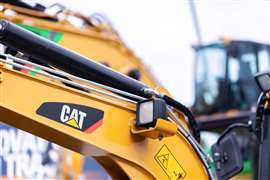Suzuki Marine balances engine performance with sustainability
24 June 2024
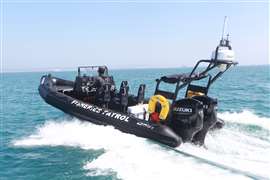 Ribcraft Fisheries Patrol vessel featuring twin four-cylinder DF175AP engines (Photo: Suzuki Marine)
Ribcraft Fisheries Patrol vessel featuring twin four-cylinder DF175AP engines (Photo: Suzuki Marine)
Suzuki Marine GB offers a broad catalogue of outboard engines suitable for virtually any application. Ranging from single-cylinder units through to V6 models, the engines are used on all types of leisure craft and commercial vessels.
“We’ve got marine engines which range in power output from 2.5 to 350 horsepower,” says Mark Beeley, head of Marine & ATV at Suzuki GB, who spoke with Power Progress International at the Seawork 2024 event in Southampton, UK. “The engines are technically advanced, which makes them cleaner and greener.”
This, he continues, is all due to the marine engines produced by Suzuki being developed specifically for use on the water. Because they are intended for this sole purpose, the company has been able to incorporate features which are not used on other Suzuki products.
“A lot of companies will use an automotive engine turned on its side,” says Beeley. “The fact that we have developed our engines only for marine applications has allowed incorporation of various features to improve efficiency. For example, our engines use our Lean Burn technology to reduce fuel consumption.”
This patented tech optimises fuel usage by adjusting the fuel/air mix, or stoichiometric ratio. Dependent on engine load, the ratio can be adjusted hundreds of times per second to achieve the most efficient mix, reducing fuel consumption and in turn cutting overall emissions.
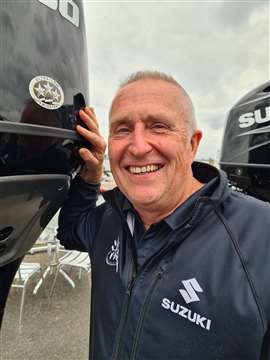 Mark Beeley, Suzuki Marine GB (Photo: PPI)
Mark Beeley, Suzuki Marine GB (Photo: PPI)
“The Lean Burn tech was originally used in cars, but it was dropped because it can’t be used with a catalytic converter,” explains Beeley. “In operation, the engine control unit interrogates the engine and, dependent on output, the Lean Burn system can come into play. When it switches to Lean Burn, the mix goes from about 15 parts air, one part fuel, to about 18 parts air. On a 200-horsepower engine that happens between 2000 and 5000 rpm.
“Unlike most engines, which have a single peak sweet spot where economy and power output are balanced for optimal fuel efficiency, the Lean Burn has a flat line. This helps to extend the number of opportunities to reduce fuel consumption.”
Clean environment
Suzuki is now building up its range of new, third-generation four-stroke engines – the company no longer offers two-stroke models in Europe. The latest of these are the DF115 BG and DF140 BG, which use a fly-by-wire control system.
Beeley says that these engines are the first to feature a microplastic collection device as standard. “It’s part of the Clean Ocean Project, which Suzuki has been running for about 15 years. There’s a collection filter on the exit of the water cooling circuit, this captures the microplastics. The unit is about the size of an egg cup; it gets filled after about 30 or 40 hours of operation in UK waters. When it’s full, the system will divert to using a bypass valve.”
A flap on the engine cover allows easy access to the filter element, which can be unscrewed and emptied. Beeley says that analysis of the collected material has shown that it is about 80% plastic.
With a laugh, he adds some further wisdom: “Don’t empty it over the side of the boat!”
While having a fuel-efficient engine, he says that the company is looking for other ways to clean up the oceans. Every Suzuki operation around the world is obliged to take one day each year where the respective team will go and help to clean up a beach, removing all the rubbish. Even the shirts the team were wearing on the Suzuki stand at Seawork 2024 are made from recycled plastic. Asked if they’re comfortable, Beeley replies: “It’s great! And you don’t have to iron it.”
Engine design
Beeley says that the Suzuki marine engine lineup is largely the same around the world, apart from those regions which offer a two-stroke model. Engines with an output up to 30 hp are manufactured in Thailand, while all others are assembled at the Suzuki plant in Hamamatsu, Japan.
While the standard outboard engine design sees the full unit hung off the stern of the boat, Suzuki has developed a different setup. This involves moving the engine block forward and a gear mechanism fitted in that space which supports an off-set driveshaft. This means that the transom supports more of the engine weight, helping with overall balance.
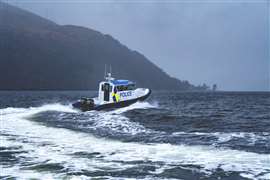 Ultimate Boats M-CLASS vessel (Photo: Suzuki Marine)
Ultimate Boats M-CLASS vessel (Photo: Suzuki Marine)
“This design allows boat builders to specify a larger engine, because [the design] helps to reduce the lever effect,” says Beeley.
Continuing, he describes how the 300, 325 and 350 V6 GEKI series engines (where the Japanese word ‘Geki’ translates to ‘parting of the seas’) have a dual propshaft setup, with one inside the other.
“If you make a larger engine, that weight will have a negative effect on the overall benefit,” explains Beeley. “It’s the same with large and small propellers; a large one will deliver more power, but also create more drag. The dual propshaft has two smaller propellers which deliver similar power as a larger unit, without the drag.”
In addition, the two propellers are counter-rotating, which helps to reduce the transverse thrust of a single large prop. This increased power delivery also helps to get the hull ‘on the plane’, reducing the time the boat has its full hull in the water, where the increased drag would clearly use more fuel.
Functionality and dependability
Moving back to look at single-propeller engines, those with outputs ranging from 150- to another 300-horsepower model, these include a feature known as selective rotation. Where most engine manufacturers have right- and left-hand units for a twin-engine boat, Suzuki avoids this by incorporating adaptable features.
With this system, each engine has a plug which can dictate the rotational direction of the propeller. The feature means Suzuki uses a single engine model to support twin-engine applications. “For the customer, especially for fleet operators, they only need to have one engine type as a backup – plus, the gearbox is more robust as they are designed to support running in both directions,” says Beeley.
As for maintenance, he says that like most manufacturers the marine engines can operate for about 100 hours before needing a service. “It’s a harsh environment, regular servicing really does help to extend the life of the engine. We’ve had some units which have delivered upwards of 20,000 hours of service, which is quite spectacular.”
All motors produced by Suzuki use petrol as fuel – asked if there are any plans for a petrol/electric hybrid, Beeley has a matter-of-fact response. “You need a lot of power to get through the water and when you’re out at sea, you need to know you can get back. Having dependable technology is critical to customer safety, so it’s unlikely we’ll look to these types of complicated solutions.”
Suzuki GB unveils new DF250 KURO
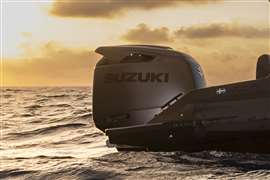 Suzuki DF250 KURO (Photo: Christophe Ponchant, Powder Point Media)
Suzuki DF250 KURO (Photo: Christophe Ponchant, Powder Point Media)
The latest marine engine to be launched by Suzuki GB is the DF250 KURO. The Japanese word ‘Kuro’ translates to ‘deep black’, which is the colour of the new engine.
The 4.0-litre 24 V V6 DF250AUNX features new electronic mapping which has allowed peak engine speed to be increased from 5700 to 6000 rpm. In addition, reworked air intake louvres deliver more air to the engine, helping to cool the engine as it gains speed.
Other changes include a redesigned lower unit which now incorporates design features taken from racing outboards to improve cruising performance and reduce cavitation. The skeg (protective propeller shroud) now features ‘left/right asymmetry’, essentially a curve which delivers improved manoeuvrability at low speeds. Upper clamp brackets now use stiffer bushings to increase stability at speed.
The DF250AUNX, which is available for single-engine installations, uses the Suzuki drive-by-wire throttle system, auto trim, keyless start and Lean Burn tech.





